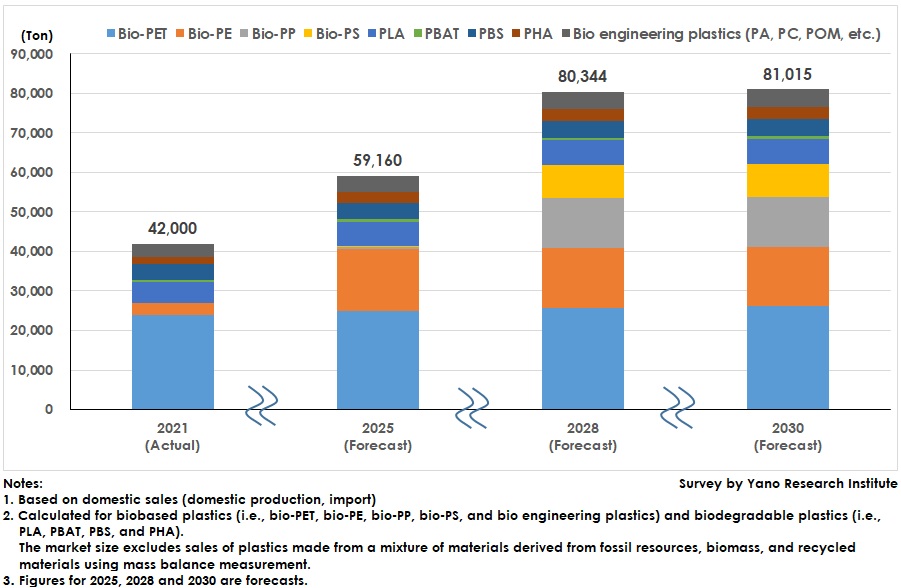No.3826
Bioplastics Market in Japan: Key Research Findings 2025
Sales of Bioplastics in Japan to Reach Around 80 Thousand Tons by 2030
Yano Research Institute (the President, Takashi Mizukoshi) surveyed the domestic bioplastics market in Japan and abroad, and revealed the market trends by material, resin, and user company, as well as the outlook. In here discloses the domestic sales volume of bioplastics through 2030.

Market Overview
Most of the petroleum-derived materials in Japan are imported. This is also true for bioplastics, such as bio polyethylene (bio-PE) and polylactic acid (PLA), most of which come from the United States and Europe. Therefore, Japan depends on other countries for these products and has been striving to change this.
This research calculates the size of the bioplastics market based on the sales of domestically produced or imported biobased plastics, which include bio polyethylene terephthalate (bio-PET), bio-PE, bio polypropylene (bio-PP), bio polystyrene (bio-PS), and bio engineering plastics; and biodegradable plastics, which include polylactic acid (PLA), polybutylene adipate terephthalate (PBAT), polybutylene succinate (PBS), and polyhydroxyalkanoates (PHA). Sales of bioplastics produced using mass balance measurements (*) are excluded.
Estimated sales of the bioplastics market, including both domestically produced and imported products, were 42,000 tons in 2021. Biobased plastics are used for plastic bags and container packaging, while biodegradable plastics are used for agricultural materials and disposable items, such as straws and cutlery.
To achieve carbon neutrality by 2050, the Ministry of Land, Infrastructure, Transport and Tourism is preparing to require the use of sustainable aviation fuel (SAF). SAF is an aviation fuel derived from waste or renewable materials. A byproduct of this process is bio naphtha. Starting in 2025, major oil refinery companies will begin producing SAF domestically. This will make domestic bioplastics derived from bio naphtha to be available for the first time. As SAF plants begin operating, the production of domestic bioplastics derived from bio naphtha is projected to steadily increase.
*) Mass balance measurement is an idea to allocate environmental value to products based on the inputs when combining and processing renewable materials, such as biomass and recycled materials, with fossil-based materials in the same manufacturing processes.
Noteworthy Topics
Bioplastics Market Trends in Japan
Petroleum refinery companies are set to begin operating plants that use hydroprocessed esters and fatty acids (HEFA) technology to produce SAF derived from edible oil waste. Bio naphtha, a byproduct of SAF production, is expected to fuel the growth in Japan's bio plastics market.
Domestic production of bio naphtha, a byproduct of domestic SAF production, is projected to reach 126 thousand tons by 2030. Domestic sales of bioplastics, including both domestic and imported products, are expected to reach 81,015 tons by 2030. This figure includes bioplastics generated from domestic bio naphtha, as well as the currently imported bio-PE and PLA. As imports of bioplastics decline, bioplastics produced domestically from bio naphtha will be crucial for the growth of the domestic bioplastics market.
Future Outlook
For the domestic bioplastics market to grow, bio-naphtha-derived bioplastics are necessary. In addition, the use of carbon dioxide (CO2)-based chemicals that do not rely on fossil-fuel derived materials has increased and is expected to be a game changer.
While European countries and the United States promote the shift to biodegradable plastics by regulating disposable plastic waste, Japan's humid climate and small land area make establish composting facilities for biodegradable plastics too risky. This makes it difficult for Japan to transition to biodegradable plastics alone.
To expand the Japanese bioplastics market, the country must introduce recyclable bioplastics made from bio naphtha or CO2, while continuing to promote the use of biodegradable plastics.
Research Outline
2.Research Object: Biodegradable plastic manufacturers, biobased plastic manufacturers, and demanders (user companies)
3.Research Methogology: Face-to-face interviews (including online) by expert researchers and literature research
About the Bioplastics Market
In Japan, the term "bioplastics" refers to two types of plastics: “biodegradable plastics”, which eventually decompose into water, carbon dioxide, and microorganisms in soil, freshwater, or seawater; and “biobased plastics” or “biomass plastics,” which are non-biodegradable and derived from edible resources, inedible biomass, or renewable organic resources, including plants.
Edible resources are plant-based materials, such as corn and sugarcane. Inedible resources are non-edible plant-based materials, such as agricultural or forestry residue and industrial by-products, which do not compete with food sources.
This research defines the bioplastics market as the market for the aforementioned biobased plastics (i.e., bio polyethylene terephthalate (PET), bio polyethylene (PE), bio polypropylene (PP), bio polystyrene (PS), and bio engineering plastics) and biodegradable plastics (i.e. polylactic acid (PLA), polybutylene adipate terephthalate (PBAT), polybutylene succinate (PBS), and polyhydroxyalkanoates (PHA). Market size is calculated based on the sales (domestically produced or imported) in Japan.
The market size excludes sales of plastics made from a mixture of materials derived from fossil resources, biomass, and recycled materials using mass balance measurement (*).
*) Mass balance measurement is an idea to allocate environmental value to products based on the inputs when combining and processing renewable materials, such as biomass and recycled materials, with fossil-based materials in the same manufacturing processes.
<Products and Services in the Market>
biodegradable plastics, biobased plastics
Published Report
Contact Us
The copyright and all other rights pertaining to this report belong to Yano Research Institute.
Please contact our PR team when quoting the report contents for the purpose other than media coverage.
Depending on the purpose of using our report, we may ask you to present your sentences for confirmation beforehand.